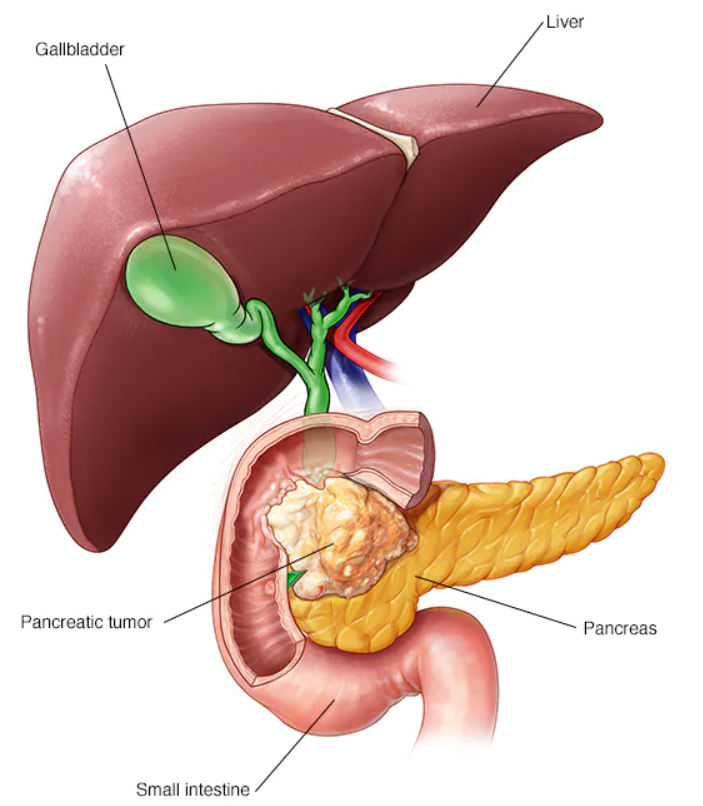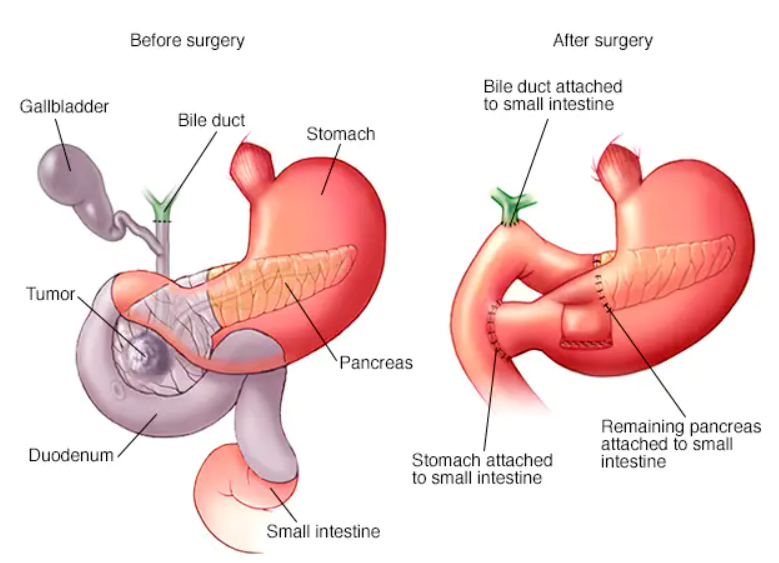Causes:
Exact cause of pancreatic cancer is not known. Doctors have identified several factors that could increase the risk of cancer, such as smoking cigarettes and having certain inherited gene mutations.
Pancreatic cancer occurs when cells in pancreas develop various mutations in their DNA. A cell's DNA contains the instructions that tell a cell what to do. These mutations causes cells to grow uncontrollably and to continue living even after normal cells would die. These accumulating cells can form a tumor. If untreated, pancreatic cancer cells could grow to distant organs and blood vessels, and even further into distant parts of the body.
The majority of pancreatic cancers start with the cells that connect the ducts in the pancreas. This kind of cancer is known as pancreatic cancer. It is less often that cancer will be found within the hormone-producing cells or neuroendocrine cells in the pancreas. These kinds of cancers are known as pancreatic neuroendocrine tumours and islet cell tumors. They are also known as pancreatic cancer of the endocrine.
Risk factors:
Factors that may increase the risk of pancreatic cancer include:
- Smoking
- Diabetes
- Chronic inflammation of the pancreas (pancreatitis)
- Genetic disorders that may increase the risk of developing cancer, such as BRCA2 gene mutations, Lynch syndrome, and familial atypical mole-malignant melanomas (FAMMM) disorder.
- Family history of pancreatic cancer
- Obesity
- Older age, as most people are diagnosed after age 65
Diagnosis:
Following tests are done to evaluate pancreatic cancers:
- Ultrasound Abdomen: : this is the first and basic test to know about the status of pancreas and other intra-abdominal organs. Though the sensitivity is poor but it can give us an idea regarding pancreatic tumor and nearby organ spread.
- Imaging tests that create pictures of internal organs. : These tests help your doctors visualize your internal organs, including the pancreas. Techniques used to diagnose pancreatic cancer include computerized tomography (CT) scans, magnetic resonance imaging (MRI) including MRCP. These imaging tests helps in diagnosing pancreatic mass and its relation to the nearby organs. It also gives an idea about the spread of the disease to other abdominal organs.
- Endoscopic ultrasound (EUS): An endoscopic ultrasound (EUS) uses an ultrasound device which is fitted to an endoscope. The device is into your stomach in order to obtain the images of pancreas. It is the prime modality to obtain tissue from the pancreatic mass for histopathological diagnosis.
- Removing a tissue sample for testing (biopsy): A biopsy is a procedure to remove a small sample of tissue from the tumor for examination under a microscope. Most often the tissue is collected during EUS by passing special tools through the endoscope. Less often, a sample of tissue is collected from the pancreas by inserting a needle through skin and into your pancreas under Ultrasonography or CT guidence.
- Blood tests. Specific proteins (tumor markers) shed by pancreatic cancer cells can be found in blood. One tumor marker test used in pancreatic cancer is called CA19-9. It can be beneficial in understanding how disease responds when treated. However, it's not always accurate since some patients who have pancreatic cancer do not have elevated levels of CA19-9 which makes the test less useful.
Staging
After diagnosing pancreatic cancer your doctor will determine the stage of cancer. Utilizing information from screening tests for staging, the doctor gives the pancreatic cancer you have an appropriate stage. This will help determine which treatments are most likely to help you.
The stages of pancreatic cancer are indicated by Roman numerals ranging from 0 to IV. The lowest stages indicate that the cancer is confined to the pancreas. By stage IV, the cancer has spread to other parts of the body.
Treatment
Treatment for pancreatic cancer depends on the stage and location of the cancer as well as overall health of the patient and personal preferences. In the majority of cases the primary purpose of treating pancreatic cancer is to eradicate the cancer if it is possible. When that is not possible, the focus may be on improving quality of life and limiting the cancer from growing or causing more harm.
Treatment includes surgery, radiation, chemotherapy or a combination of these. When pancreatic cancer is advanced and these treatments aren't likely to offer a benefit, doctor will focus on symptom relief (palliative care) to keep the patient as symptom free as possible.
Best Pancreatic Cancer Surgery
Surgery is mainstay of treatment in cases of localized pancreatic cancers. Operations used in people with pancreatic cancer include:
- Surgery for tumors in the pancreatic head. Most commonly pancreatic cancers occur in the head region of pancreas. In this case patient will require Whipple’s procedure (pancreaticoduodenectomy).
The Whipple procedure is a technically difficult operation to remove the head of the pancreas, the first part of the small intestine (duodenum), the gallbladder, part of the bile duct and nearby lymph nodes. In some situations, part of the may be removed as well. Your surgeon reconnects the remaining parts of your pancreas to the remaining part of the bile duct, stomach and intestines to allow you to digest food.
- Surgery for tumors in the pancreatic body and tail. Surgery to remove the left side (body and tail) of the pancreas is called distal pancreatectomy. In these cases, spleen is also often removed.
- Surgery to remove the entire pancreas. . In some people, the entire pancreas may need to be removed. This is called total pancreatectomy. You can live relatively normally without a pancreas but do need lifelong insulin and enzyme replacement.
- Surgery for tumors affecting nearby blood vessels. Many people with advanced cancer aren't eligible for the Whipple procedure or other pancreatic surgeries if their tumors involve nearby blood vessels. At highly specialized and experienced medical centers, surgeons may offer complex pancreatic surgeries that include removal and reconstruction of affected blood vessels with the help of various grafts.
Each of these surgeries carries the risk of bleeding, leak and infection though the chances varies depending upon various factors. After surgery some people may experience nausea and vomiting if the stomach is not emptying properly (delayed gastric emptying). Expect a long recovery after any of these complex procedures. Extensive research shows pancreatic cancer surgery tends to cause fewer complications when done by highly experienced surgeons at centers that do many of these operations.
Now a days many of these procedures are performed with the help of Robotic technology with high precision and equal oncologic outcomes. We are one of the very few centers to offer Robotic Pancreatic Surgeries.
Chemotherapy:
Chemotherapy uses drugs to help kill cancer cells. These drugs can be injected into a vein or taken orally. One may receive one chemotherapy drug or a combination of them.
Chemotherapy can also be combined with radiation therapy (chemoradiation). Chemoradiation is typically used to treat advanced pancreatic cancer that hasn't spread beyond the pancreas. At specialized medical centers, this combination is often used before surgery in locally advanced pancreatic cancers to help shrink the tumor to make it operable. Sometimes it is used after surgery to reduce the risk that pancreatic cancer may recur.
In people with advanced pancreatic cancer and metastatic cancer, chemotherapy may be used to control cancer growth, relieve symptoms and prolong survival.
Radiation therapy:
Radiation therapy utilizes beams of high energy, like the ones that are made up of X-rays and protons, in order to kill cancerous cells. Patients can receive radiation therapy either prior to or after surgery for cancer typically in conjunction with chemotherapy. It could also be suggested for pancreatic cancers that cannot treat surgically.
The majority of radiation therapy comes from the use of a device that circulates around your body, directing radiation towards certain areas of the body (external beam radiation). In medical facilities that are specialized treatments, radiation therapy can be administered during the course of surgery (intraoperative radiation) to the post-operative bed.
Traditional radiation therapy uses X-rays to treat cancer, but a newer form of radiation using protons is available at some medical centers. In certain situations, proton therapy can be used to treat pancreatic cancer and it may offer fewer side effects compared with standard radiation therapy.
Supportive (palliative) care:
Palliative care is specialized medical care that focuses on relieving symptoms from advanced cancers. Palliative care is offered by teams of nurses, doctors social workers, as well as other specialists who have been specially trained. They aim to improve their quality of life for patients suffering from cancer as well as their families.
Specialists in palliative care are able to work alongside you, your family and other physicians to provide a second layer of support to complement your regular medical care. This is often required when you are undergoing extreme treatments, like chemotherapy, surgery and radiation therapy.
When palliative treatment is employed in conjunction with other treatments patients with cancer, they may be healthier and last longer.

